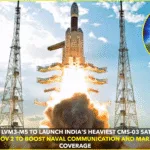On the night of September 7–8, 2025, the skies over India will host a rare celestial spectacle — a total lunar eclipse, popularly called the Blood Moon. This breathtaking phenomenon occurs when the Earth passes directly between the Sun and the Moon, casting its shadow across the lunar surface. Instead of vanishing into darkness, the Moon transforms into a mesmerizing red-orange orb, glowing mysteriously in the night sky.
For stargazers, astronomers, and casual skywatchers alike, this event promises to be one of the most memorable of the year. Unlike solar eclipses, which require protective glasses, lunar eclipses can be viewed safely with the naked eye, making it a family-friendly event for everyone under the night sky.
The Science Behind the Blood Moon
During a total lunar eclipse, sunlight bends around the Earth’s atmosphere and filters onto the Moon’s surface. Shorter wavelengths like blue and violet scatter away, while longer red and orange wavelengths dominate, giving the Moon its signature fiery hue.
This “Blood Moon” effect has fascinated civilizations for centuries, often inspiring myths and cultural interpretations. In modern times, it continues to spark excitement among scientists and skywatchers alike, not for superstition, but for its sheer beauty.
Timing and Duration of the Eclipse
The September 2025 lunar eclipse will last several hours, with totality — the phase when the Moon is completely immersed in Earth’s shadow — stretching for 82 minutes. That makes it one of the longest visible eclipses in recent years.
In India, the eclipse will begin late on September 7 and continue into the early hours of September 8. The exact timings will vary depending on location, but most regions will enjoy a clear view of the eclipse from start to finish, provided the skies remain cloud-free.
How to Watch the Eclipse Safely
One of the best things about lunar eclipses is that they are completely safe to view. No special equipment or protective gear is required. Here are some tips to enhance your experience:
- Choose an open space: Find a location away from city lights for the clearest view of the night sky.
- Bring binoculars or a telescope: While not necessary, these can enhance details like the Moon’s craters as they shift under the red glow.
- Check local weather: Cloud cover can obscure the view, so keep an eye on forecasts and pick a spot with the best conditions.
- Capture the moment: A smartphone or DSLR camera on a tripod can help you take stunning photos of the Blood Moon.
Cultural and Scientific Significance
Lunar eclipses have always carried cultural weight. In India, ancient texts often described them as cosmic battles between celestial forces. Today, these events hold more scientific and educational importance. Schools, astronomy clubs, and observatories across the country are expected to organize public viewings, turning the night into a festival of science and stargazing.
Astronomers also use eclipses as opportunities to study Earth’s atmosphere. The colors of the eclipse can reveal details about dust and pollution levels in the upper layers of the air, making it a natural laboratory in the sky.
A Celestial Show Not to Be Missed
For many, this September’s Blood Moon will be a once-in-a-lifetime sight. While lunar eclipses occur regularly, not all of them are visible across India with such a long duration of totality. The spectacle of an 82-minute crimson Moon hanging in the night sky is sure to be remembered by all who witness it.
So, mark your calendars for the night of September 7–8, 2025. Step outside, look up, and let the Blood Moon remind you of the vast, mysterious beauty of the universe.










